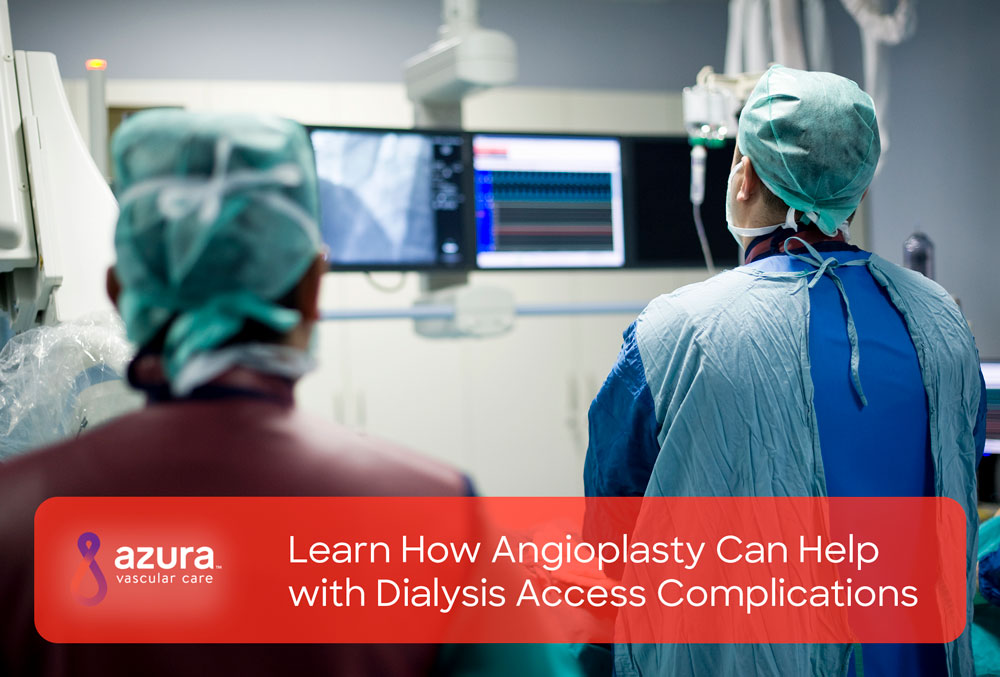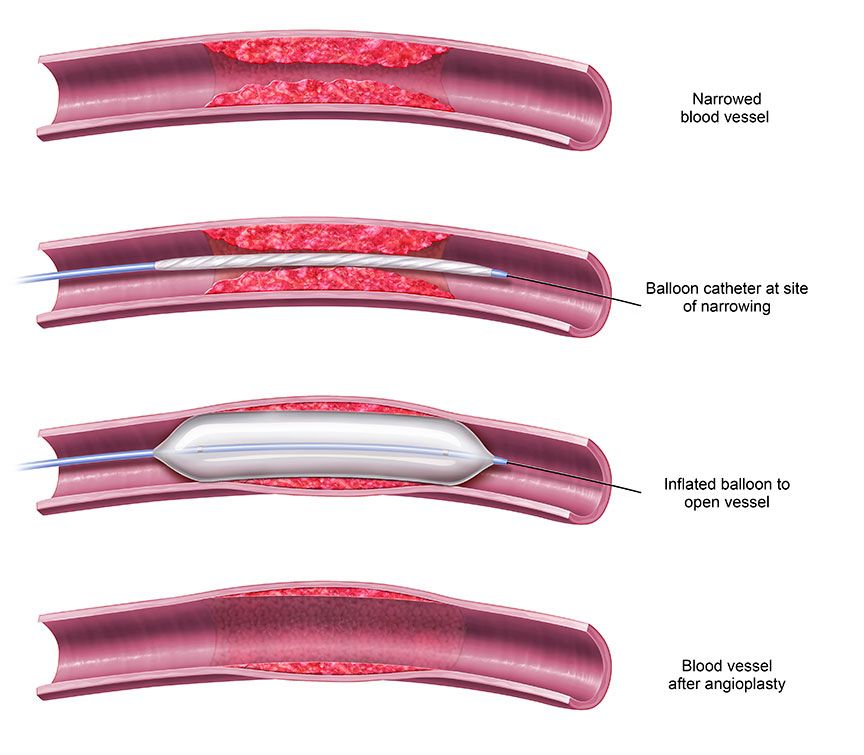
If you’re receiving hemodialysis treatments, it’s imperative that your AV fistula or graft is working properly. A functioning fistula or graft is necessary to allow blood to travel through soft tubes to the dialysis machine where it can be cleaned and then returned to your body.
However, on occasion your dialysis access may stop working well or cease working altogether due to a narrowing or blockage (clot) of one or more of the blood vessels in your fistula or graft. When these dialysis access complications occur, you may require a procedure called an angioplasty to reopen your access so you can continue to receive dialysis treatment. (i)
What is Angioplasty?
Angioplasty is a simple, minimally invasive procedure performed by a vascular specialist to reopen narrowed or blocked blood vessels.

You may already be familiar with coronary angioplasty, which is used to open vessels in the heart, or peripheral angioplasty which is commonly performed to restore blood flow in the legs. Yet angioplasty can also be utilized to restore blood flow to your dialysis fistula or graft if a narrowing or blockage occurs. In the clinical setting, you may hear this referred to as balloon angioplasty or dialysis access repair. (i,ii,iii)
Why Would I Need an Angioplasty for my Dialysis Access?
When you are receiving dialysis treatment, it is essential that your vascular access is working correctly and can maintain adequate blood flow to and from the hemodialysis machine during the treatment.
Sometimes, however, the blood flow rate through your access is inadequate due to a narrowing of a blood vessel in the fistula or graft, or it may suddenly stop working altogether. This can be evident when you or your dialysis team notices that during the dialysis treatment the dialysis machine is alarming indicating inadequate blood flow to the machine or increased pressure signifying difficulty with the return of blood to your body. If this occurs you may be unable to receive or complete your scheduled hemodialysis treatment. In addition, the palpable thrill that can be normally felt over your fistula or graft may feel weaker or may no longer be felt at all.
If this happens, your doctor will likely order a fistulogram, this is a type of imaging study that will help visualize the location and severity of any narrowing or blockage of your fistula or graft blood vessels. Depending on the results of the fistulogram if your doctor identifies dialysis access complications such as a significant narrowing or blockage within your dialysis fistula or graft, he or she may perform an angioplasty to unblock your vascular access and restore adequate blood flow, so you can resume dialyzing as normal.
What Occurs During an Angioplasty Procedure for my Dialysis Access?
During angioplasty, your doctor will administer a local anesthetic to your access limb, usually in one of your arms. You may also receive a sedative to feel relaxed, sleepy and comfortable for the procedure.
After you’re prepped for the procedure, a vascular specialist or interventional radiologist will make a small incision in your arm and will use special imaging techniques to visualize the vessels and determine the location of any blockage(s). This type of imaging is called an angiogram. An angiogram is a type of x-ray that uses a special dye and x-ray machine to take pictures of blood flow in and around your fistula or graft.
Once your doctor has identified the area of narrowing or blockage, he or she will introduce a soft tube called a catheter into the dialysis access. You may feel some pressure when the catheter is inserted, but you shouldn’t feel any significant discomfort.
This catheter is then advanced to the area of narrowing. Once it is properly in place, a balloon at the end of the catheter will be inflated. This balloon works to push any blockage against the interior walls of the vessel, thereby widening the diameter of the vessel and restoring blood flow. Sometimes a tiny mesh tube called a stent is also utilized in the procedure. The stent is placed on top of the balloon, so once the balloon is inflated, it secures the stent against the wall of the blood vessel to help keep it open. Once the procedure is completed, the balloon is then deflated, and the balloon catheter is removed from the access. (i, iv, v)
Benefits of Using Angioplasty for Dialysis Access Repair
Before minimally invasive catheter-based procedures like balloon angioplasty, patients would have to undergo open surgical procedures in the operating room to fix a malfunctioning dialysis access which required hospital stays and a lengthy healing process.
Now, with balloon angioplasty being commonly utilized for dialysis access repair, patients can have their fistula or graft fixed within a few hours and typically on an outpatient basis with only local anesthesia. No large surgical incision is necessary to perform an angioplasty, only a small nick in the skin that does not require stitches. Most patients can return to normal activities shortly after the procedure as well as resume dialysis treatment. (i)
Risks of Using Angioplasty for Dialysis Access Repair
Major dialysis access complications following angioplasty are uncommon. However, there is a possibility of an allergic reaction from the contrast dye used during the imaging portion of the angiography, as well as a small risk of the catheter injuring the wall of the artery or vein.
Although rare, heavy bleeding from the catheter site may also occur. Bruising or discoloration may also be present at the site. Your doctor or nurse will carefully explain any symptoms to be aware of and/or when you should seek additional medical attention for potential issues. (i)
Are There Any Limitations with Angioplasty for Dialysis Access Repair?
Re-narrowing of the blood vessels can occur after a balloon angioplasty is performed, even when a stent is used. However, in many cases, an angioplasty can be repeated. Angioplasty is typically an effective and minimally invasive way to treat a narrowing or blockage.
Some areas of narrowing or blockage may be too severe and too difficult to open with balloon angioplasty. If this is the case, your doctor may want to place a temporary dialysis access device, like a central venous catheter (CVC), until a surgeon is able to fix or revise your dialysis fistula or graft. (i)
Sources:
Sources:
(i) Radiology Info. (January 23, 2019). Dialysis and Fistula/Graft Declotting and Interventions. Retrieved August 19, 2019, from https://www.radiologyinfo.org/en/info.cfm?pg=dialysisfistulagraft.
(ii) American Heart Association. (2015). What Is Coronary Angioplasty? Retrieved August 19, 2019, from https://www.heart.org/media/data-import/downloadables/pe-abh-what-is-coronary-angioplasty-ucm_300437.pdf.
(iii) Mayo Clinic. (n.d.). Coronary angioplasty and stents. Retrieved August 19, 2019, from https://www.mayoclinic.org/tests-procedures/coronary-angioplasty/about/pac-20384761.
(iv) Radiology Info. (February 26, 2019). Angioplasty and Vascular Stenting. Retrieved August 19, 2019, from https://www.radiologyinfo.org/en/info.cfm?pg=angioplasty.
(vi) Bojakowski, K., Góra, R., Szewczyk, D., & Andziak, P. (2013). Ultrasound-guided angioplasty of dialysis fistula – technique description. Polish journal of radiology, 78(4), 56–61. doi:10.12659/PJR.889524.


